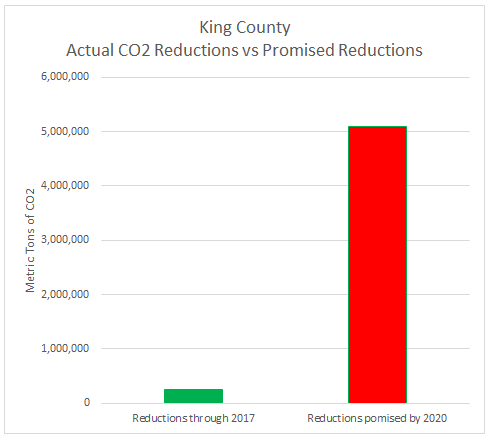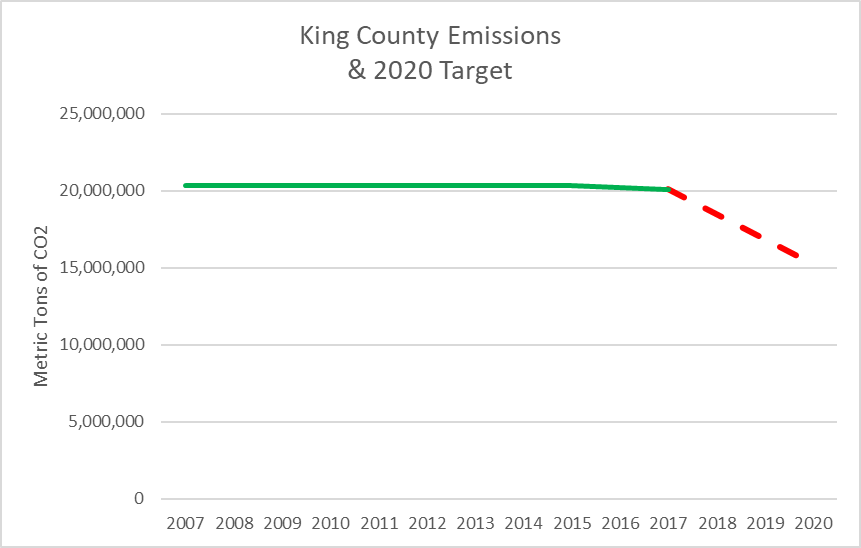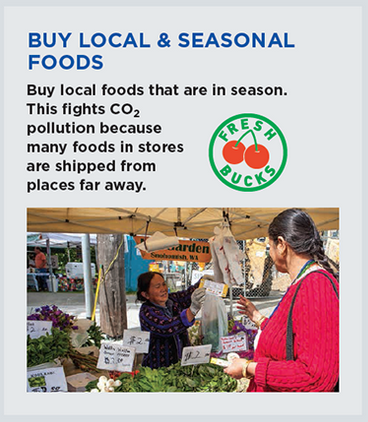Today, King County released its 2020 Climate Action Plan. Already, county public relations staff have been busy touting the “accomplishments” of the last climate plan. One thing they don’t mention, however, is that the county is on track to miss its self-imposed 2020 CO2 reduction target by 96 percent.
You won’t see that anywhere in the long press release from County Executive Dow Constantine. Instead, he claims the county “surpassed many of our goals.” Touting procedural successes while completely failing to achieve tangible goals is emblematic of  the lack of seriousness by politicians who claim to be most concerned about climate change. Rather than being chastened by that failure, however, the County Executive will use the poor performance as an excuse to double-down on the same policies that have performed so miserably.
the lack of seriousness by politicians who claim to be most concerned about climate change. Rather than being chastened by that failure, however, the County Executive will use the poor performance as an excuse to double-down on the same policies that have performed so miserably.
In 2008, King County set a goal to reduce countywide CO2 emissions by 25 percent between 2007 and 2020. Last year, the county released its most recent inventory, accounting for emissions through 2017. According to the report, “2017 geographic plus emissions decreased by an estimated 1.2% compared to 2007. This trend is not on track toward King County and Growth Management Planning Council (GMPC) adopted greenhouse gas (GHG) reduction targets that include a near term goal of a 25% reduction in countywide GHG emissions by 2020 compared to 2007.” To achieve the CO2 reduction goal, emissions in the county would have had to dramatically fall during the past three years.
 It is certain that did not occur, in part because the county has emphasized approaches that are actually harmful while ignoring approaches that would be extremely successful.
It is certain that did not occur, in part because the county has emphasized approaches that are actually harmful while ignoring approaches that would be extremely successful.
For example, King County public relations staff created a series of graphics about climate change. One of the things they recommend is to “buy local” foods. They claim, “This fights CO2 pollution because many foods in stores are shipped from places far away.” With a few exceptions, buying local food actually increases CO2 emissions.
The first problem is that the county, and others who support “buy local,” never define what “local” is. Is it just King County? Does buying apples from Wenatchee count? It is a meaningless term that isn’t defined because there is no data-driven basis for the claim.
 In fact, buying local food often uses more energy, fertilizer, and other resources. Transportation is a small percentage of total energy associated with produce. Growing food where it is appropriate and using a small amount of energy to ship it is far more environmentally friendly. This is well known to those in agriculture. Agricultural economist Steven Sexton calculated that “It would take Michigan 14 acres to grow the strawberries California produces on a single acre.” In a piece we wrote together, he and I noted, “By our estimates, at least 60 million additional acres of farmland—an area the size of Oregon—would be required to locally produce 40 crops at current yields.”
In fact, buying local food often uses more energy, fertilizer, and other resources. Transportation is a small percentage of total energy associated with produce. Growing food where it is appropriate and using a small amount of energy to ship it is far more environmentally friendly. This is well known to those in agriculture. Agricultural economist Steven Sexton calculated that “It would take Michigan 14 acres to grow the strawberries California produces on a single acre.” In a piece we wrote together, he and I noted, “By our estimates, at least 60 million additional acres of farmland—an area the size of Oregon—would be required to locally produce 40 crops at current yields.”
Is it any wonder King County is failing when they can’t even get these sorts of basic calculations correct?
There is a way to rapidly cut CO2 emissions in a way that is effective and affordable. There is a market for CO2-reducing projects that are certified effective. Seattle City Light uses this market and pays $7 for every metric ton of CO2 reduced.
This approach is not only more effective than the current approach, it is far less expensive. The County Executive and the special interests praising the county’s failed record, however, are unlikely to use more effective approaches because they do not allow county politicians to reward political allies who, in turn, praise the county’s work even as they fail.




